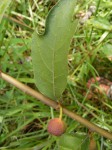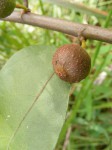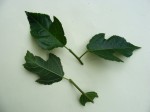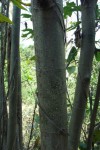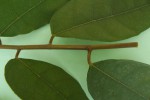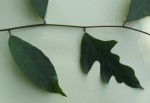| Home | > | List of families | > | Moraceae | > | Ficus | > | asperifolia |
Ficus asperifolia
Selected images: Click on each image to see a larger version and details of the record View all images (8)
Detailed records: Display species records QDS maps by: Google Maps Point records by Google Maps
Species details: Click on each item to see an explanation of that item (Note: opens a new window)
| Synonyms: | |
| Common names: | |
| Frequency: | |
| Status: | |
| Description: |
Shrub up to 5 m. tall, suckering from the base to produce colonies, with whip-like branches. Leaves very variable in shape, mostly asymmetric at the base; lateral veins in 3-10 pairs; lamina papery, rough to the touch. Figs 1-3 together, in leaf axils or just below the leaves. Separate male and female plants; stipules not completely enclosing the stem apex; figs with bracts on the receptacle as well as basal and osteolar. Figs growing and ripening sequentially. |
| Type location: |
Nigeria |
| Notes: | |
| Derivation of specific name: | |
| Habitat: | |
| Altitude range: (metres) | |
| Flowering time: | |
| Worldwide distribution: | From Senegal and South Sudan to Tanzania and Angola.In Zambia widespread in the northern higher-rainfall areas. |
| National distribution: | |
| Growth form(s): | Tree, shrub over 2 m. |
| Endemic status: | |
| Red data list status: | |
| Insects associated with this species: | Kradibia gastroi afrum (Pollinated by this insect) |
| Spot characters: | Display spot characters for this species |
| Literature: |
Berg, C.C. (1991). Moraceae Flora Zambesiaca 9(6) Page 48. Burrows, J.E. & Burrows, S.M. (2003). Figs of Southern and South-Central Africa Umdaus Press, South Africa Pages 50 - 52. (Includes a picture). Chapano, C. & Mamuto, M. (2003). Plants of the Chimanimani District National Herbarium and Botanic Garden, Zimbabwe Page 27. |
Other sources of information about Ficus asperifolia:
Our websites:
Flora of Zambia: Ficus asperifoliaExternal websites:
African Plants: A Photo Guide (Senckenberg): Ficus asperifoliaBHL (Biodiversity Heritage Library): Ficus asperifolia
EOL (Encyclopedia of Life): Ficus asperifolia
GBIF (Global Biodiversity Information Facility): Ficus asperifolia
Google: Web - Images - Scholar
iNaturalist: Ficus asperifolia
IPNI (International Plant Names Index): Ficus asperifolia
JSTOR Plant Science: Ficus asperifolia
Mansfeld World Database of Agricultural and Horticultural Crops: Ficus asperifolia
Plants of the World Online: Ficus asperifolia
Tropicos: Ficus asperifolia
Wikipedia: Ficus asperifolia
| Home | > | List of families | > | Moraceae | > | Ficus | > | asperifolia |
